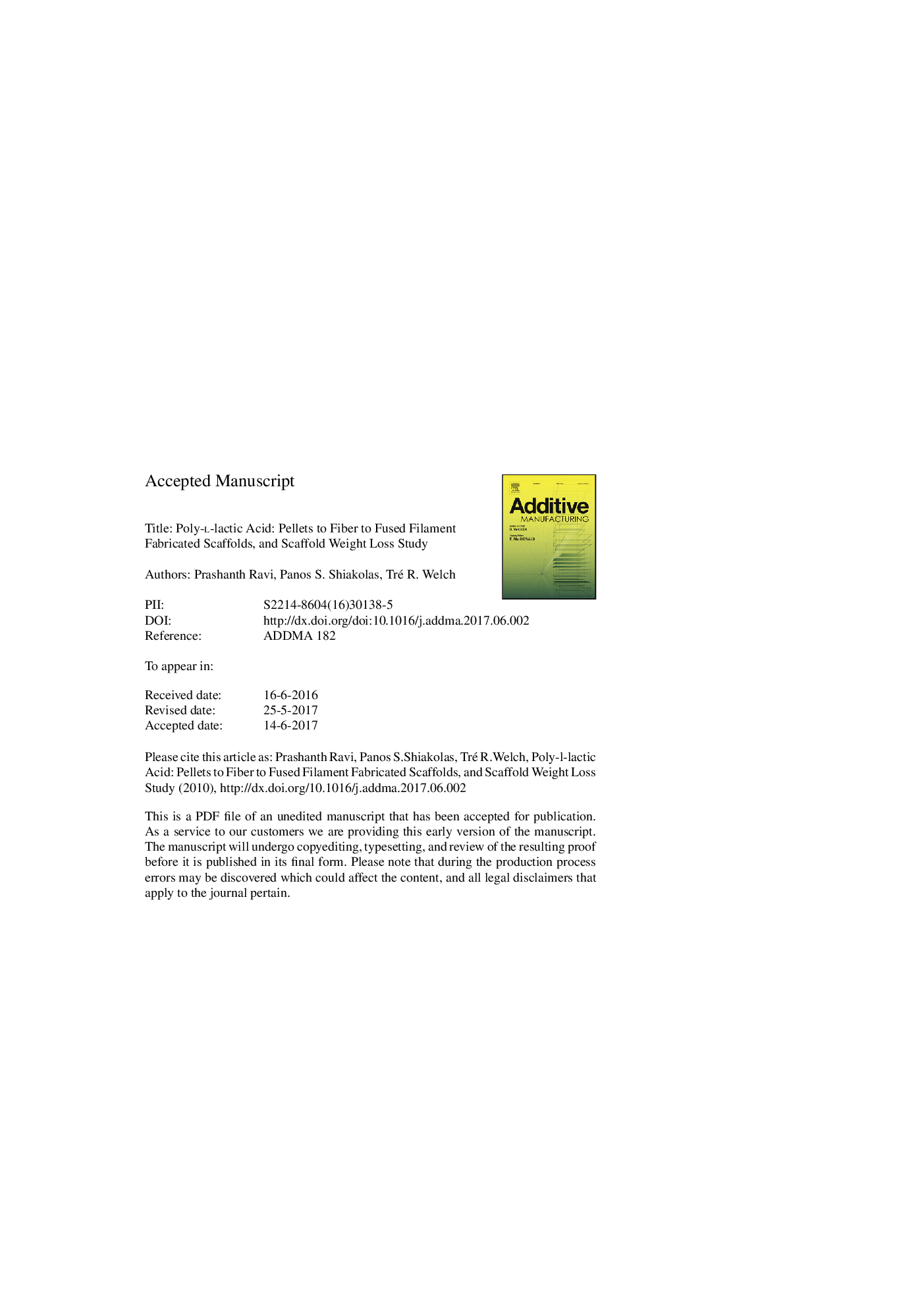| کد مقاله | کد نشریه | سال انتشار | مقاله انگلیسی | نسخه تمام متن |
|---|---|---|---|---|
| 5020135 | 1468633 | 2017 | 35 صفحه PDF | دانلود رایگان |
عنوان انگلیسی مقاله ISI
Poly-l-lactic acid: Pellets to fiber to fused filament fabricated scaffolds, and scaffold weight loss study
دانلود مقاله + سفارش ترجمه
دانلود مقاله ISI انگلیسی
رایگان برای ایرانیان
کلمات کلیدی
NBDFFFPSISLAPLASTLSLSPIDRPMPLLALNCsPCLPGAStandard Tessellation Language3DPPBSDSCL/D - L / DStereolithography - استریولیتوگرافیPoly-L-lactic acid - اسید Poly-L-لاکتیکPoly-lactic acid - اسید پلی اتیلنrevolution per minute - انقلاب در هر دقیقهUltra violet - بسیار بنفشanalysis of variance - تحلیل واریانسANOVA - تحلیل واریانس Analysis of varianceAdditive manufacturing - تولید افزودنیFused filament fabrication - تولید رشتهglass transition temperature - دمای انتقال شیشهMelting Temperature - دمای ذوبCrystallization temperature - دمای کریستالیزاسیونCAD - طراحی به کمک رایانه یا کَدComputer-aided design - طراحی به کمک کامپیوترPhoto-polymerization - عکس پلیمریزاسیونproportional-integral-derivative - متناسب با انتگرال مشتق شدهPhosphate-buffered saline - محلول نمک فسفات با خاصیت بافریSEM - مدل معادلات ساختاری / میکروسکوپ الکترونی روبشیscanning electron microscope - میکروسکوپ الکترونی اسکنSelective Laser Sintering - پخت لیزر انتخابیPolycaprolactone - پلی کاپرولاکتونpounds per square inch - پوند بر اینچ مربعDifferential scanning calorimetry - کالریمتری روبشی افتراقی
موضوعات مرتبط
مهندسی و علوم پایه
سایر رشته های مهندسی
مهندسی صنعتی و تولید
پیش نمایش صفحه اول مقاله

چکیده انگلیسی
Poly-l-lactic acid (PLLA) is a bioresorbable polymer used in a variety of biomedical applications. Many 3D printers employ the fused filament fabrication (FFF) approach with the ubiquitous low-cost poly-lactic acid (PLA) fiber. However, use of the FFF approach to fabricate scaffolds with medical grade PLLA polymer remains largely unexplored. In this study, high molecular weight PL-32 pellets were extruded into â¼1.7 mm diameter PLLA fiber. Melt rheometric data of the PLLA polymer was analyzed and demonstrated pseudo-plastic behavior with a flow index of n = 0.465 (<1). Differential scanning calorimetry (DSC) was conducted using samples from the extruded fiber to obtain thermal properties. DSC of the 3D printed struts was also analyzed to assess changes in thermal properties due to FFF. The DSC and rheometric analysis results were subsequently used to define appropriate FFF process parameters. Constant porosity scaffolds were FFF 3D printed with 4 distinct laydown patterns; 0/90° rectilinear (control), 45/135° rectilinear, Archimedean chords, and honeycomb using the in-house developed custom multi-modality 3D bioprinter (CMMB). The effect of laydown pattern on scaffold bulk erosion (weight loss) was studied by immersion in phosphate-buffered saline (PBS) over a 6-month period and measured monthly. A repeated measures analysis of variance (ANOVA) was performed to identify statistically significant differences between mean percent weight loss of the four laydown patterns at each time point (1-6 months). The resulting data follows distinct temporal trends, but no statistically significant differences between means at individual time points were found. Cross-sectional scanning electron microscope (SEM) images of the 6-month degraded scaffolds showed noticeable structural deterioration. The study demonstrates successful processing of PLLA fiber from PL-32 pellets and FFF-based 3D printing of bioresorbable scaffolds with pre-defined laydown patterns using medical grade PLLA polymer which could prove beneficial in biomedical applications.
ناشر
Database: Elsevier - ScienceDirect (ساینس دایرکت)
Journal: Additive Manufacturing - Volume 16, August 2017, Pages 167-176
Journal: Additive Manufacturing - Volume 16, August 2017, Pages 167-176
نویسندگان
Prashanth Ravi, Panos S. Shiakolas, Tré R. Welch,